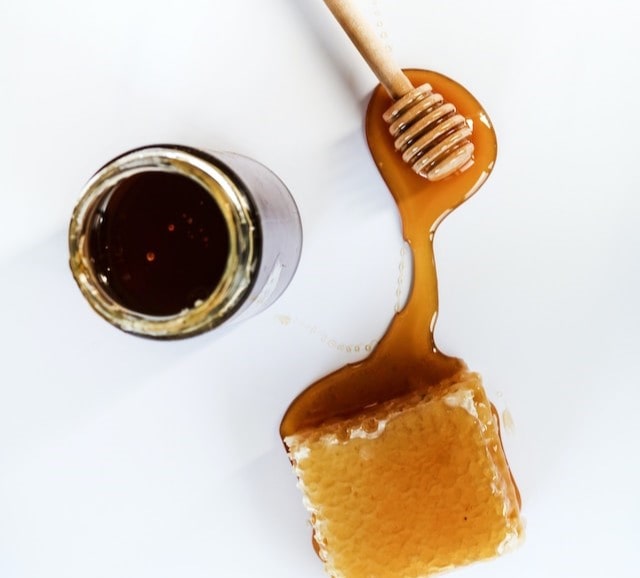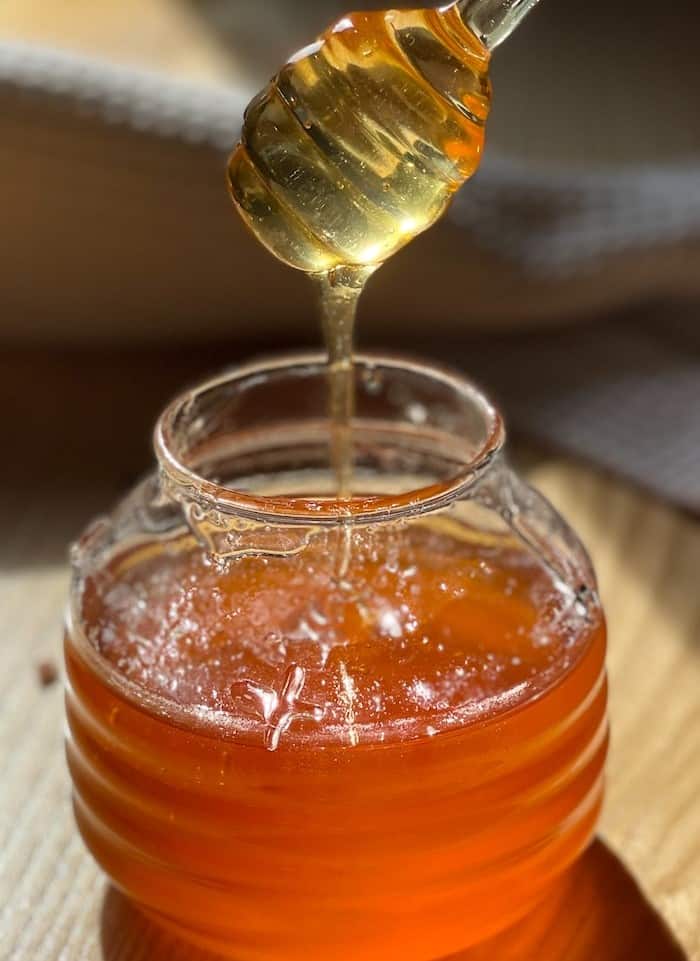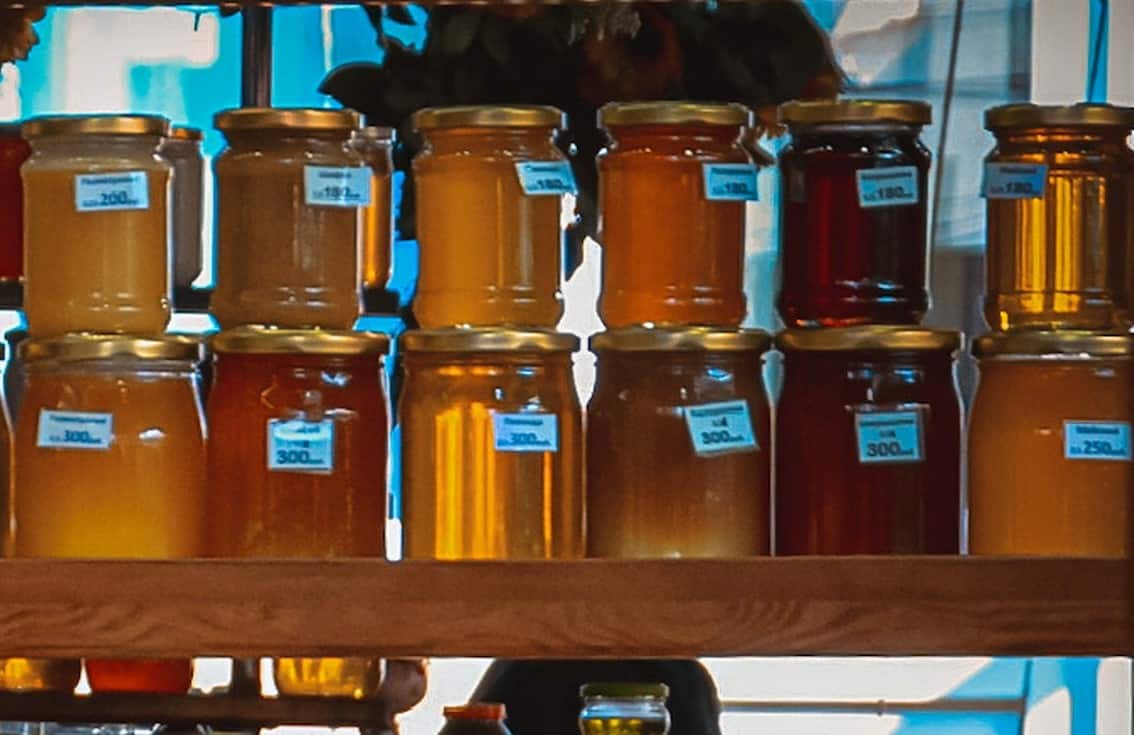What is the color of honey? Does honey color determine its taste?
As with most questions bee-related, there’s more than one answer. Honey comes in all shades and flavors straight from the hive.
Beekeepers have little control when it comes to the flavor and color of honey. That’s because it is determined by the source of nectar.
The honey bees don’t care about the color of this prized commodity. All they are looking for is a source of energy to consume and store.
So, the value placed on honey’s appearance is mostly arbitrary. That said, there is some relationship between the color of honey and its components.

Honey Colors
The Agricultural Marketing Service of the U.S. Department of Agriculture classifies honey into seven types, based on its color.
The Agricultural Marketing Service has the following color categories:
- Water white
- Extra white
- White
- Extra light amber
- Light amber
- Amber
- Dark amber
In some cases, the colors of honey tell you something about it. We will discuss more of this below.

What does Color tell you about its Source?
A honey’s color would sometimes depend on the nectar source used to produce the honey. Depending on the flower source and the plant species, the extracted honey would vary in color.
Different plants produce flowers of varying colors and distinct nectar. Depending on this, most honey the bees produced by collecting nectar from tiny white flowers would be categorized as extra white honey or water white honey, based on the color standards of the USDA.
On the other hand, the honey is dark if the bees forage floral nectars of dark-colored blossoms.
Honey can either be monofloral or polyfloral. When honey bees are used to pollinate orchards or large farms, the result is honey from a single type of plant.
Blueberry honey is a good example. The resulting color and flavor will be a direct result of the nectar from the blueberry plant. It’s medium amber in color.
Tupelo honey is another popular monofloral honey. It has a beautiful golden, rich amber color and is slow to crystallize, making it a table favorite and pushing up its value.
On the other side of the spectrum, we have buckwheat honey. Buckwheat honey is one of the darker-colored honey, almost dark brown.
On the other hand, wildflower honey, or honey from undefined flower sources, is usually dark in color with a blend of flavors. Polyfloral honeys, due to the many nectar sources from varying flowers and plants, have more undeterminable colors.
On a general note, dark honey comes from the nectar of flowers that are rich in minerals and other components. In other instances, dark honeys tell you that the nectars were gathered by bees from the flowers of dark-colored fruits, too.

Take, for example, the case of Blackberry honey. This honey comes from the flowers of the blackberry bushes that produce dark-colored fruits.
Also, the long storage of some honey may also cause it to turn to a darker color.
You can find a description of some types of honey here.
What does Color tell you about its Taste?
There’s a general rule that lighter honey has a milder taste while dark-colored honey has a strong flavor. However, as with every rule, there are exceptions.
Although a variety may share the same hue, it can taste completely different. Take, for example, clover and orange blossom honey. Though the two have almost the same colors, Clover honey is milder in flavor, while Orange Blossom honey has hues of citrus hint.
This might also be a bit subjective. People have diverse preferences as to what a mild flavor is.
It’s also possible to find honey from the same plant but from different states or countries. This difference would also affect the taste. In the same way, the minerals in the soil and the climate affect the flavor of the fruit, and the same thing happens to honey.
So, the link between honey color and flavor is not static and heavily relies on your preference. But it’s a safe bet that if your taste buds are easily overwhelmed, lighter-colored honey would be the better choice.

What does Color tell you about its Value?
This is a little more interesting. Some people think of honey as a thick golden liquid, generally.
When you go to a grocery store or a farmer’s market, your hand will reach out for a light-colored bottle of honey. So it’s no surprise that typically light amber honey fetches a higher price than unusually colored honey or dark honey.
Traditionally, light honey fetched more value. But that has changed over the years, and the darker honeys are now preferred.
Of course, there are lots of other variables that determine the price of honey, but the color is definitely a factor.
Naturally, the flavor has a say in the price as well. Since there’s a link between flavor and color, it’s clear to see the relationship between color and price because of its taste.
Flavor described as strong can be perceived as unpleasant. Light-colored honey can only be tagged as bland at worst. So, to the regular consumer, most likely, it tastes sweeter than something more robust.
What does Color tell you about its Quality?

The quality of honey has several variables, including water content and nutritional value. The color can’t tell you much about its moisture content, but the level of moisture can affect its color in storage.
Honey is known to degrade depending on its storage conditions. Honey with a higher level of moisture darkens after long-term storage. If the storage areas have high temperatures, the color darkens even further.
Honey is, by nature, hydrophilic. It attracts moisture and will do so readily from the air. For these reasons, some beekeepers will invest in a drying room where they will try to dry out frames of honey before extraction.
High moisture in honey won’t only affect the color but also the shelf life of honey.
The other aspect of quality is nutrition. Studies have shown that darker honey had higher antioxidant properties than lighter honey.
Manuka honey, known for its hydrogen peroxide levels, is of a medium to dark amber color. Wild honey is also known to be dark and rich in health benefits.
That doesn’t mean, though, that lighter honey offers no nutritional benefits. On a basic level, honey is simple sugars from nectar dissolved in a little water with traces of other elements.
Verdict on Honey Color: Light vs. Dark
Ultimately, your choice of honey comes down to preference. You can change things up once in a while.
Even though we can make recommendations, your pallet is the final judge. One man’s overwhelming flavor is someone else’s rich experience.
What color of honey is the best? Only you can tell.
